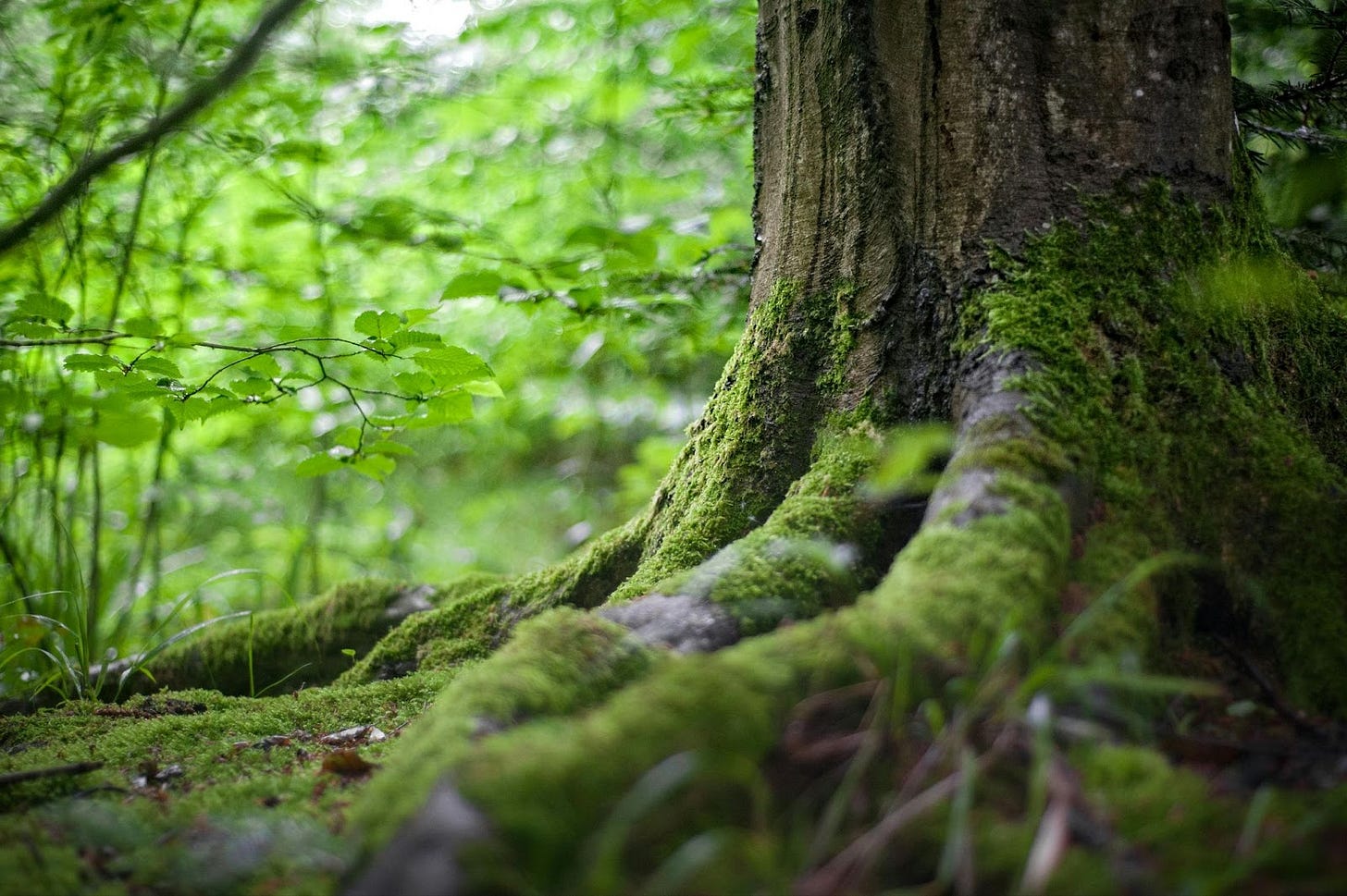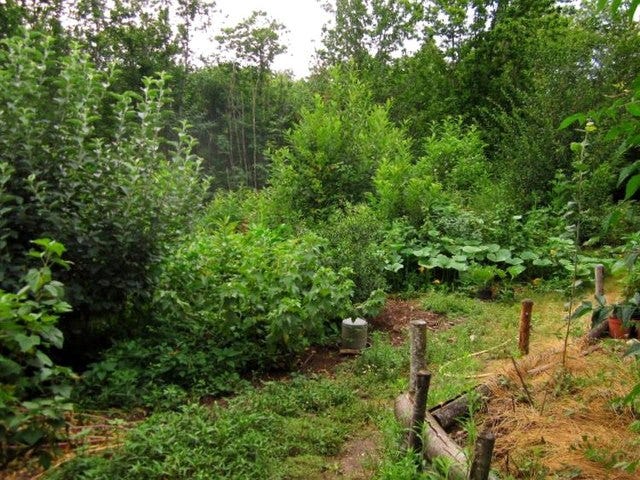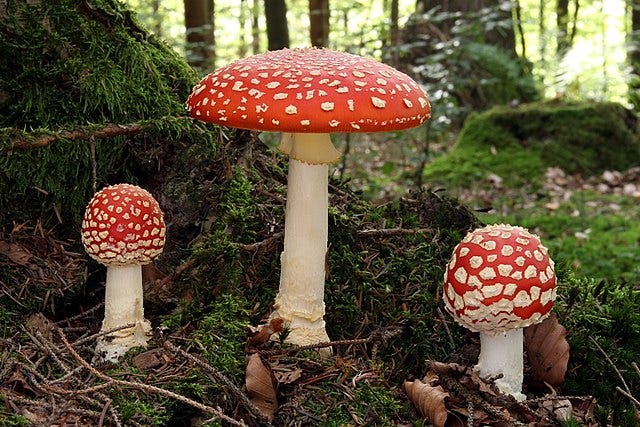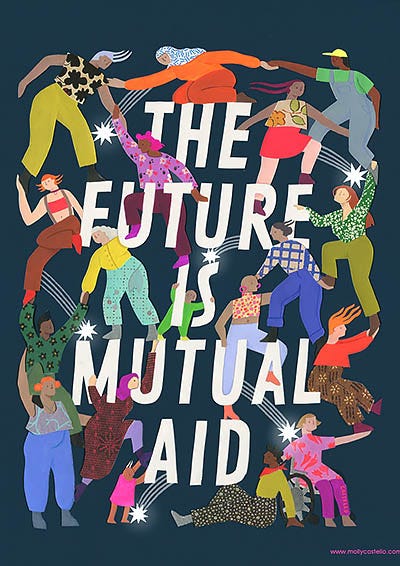Notes From the Underground: How Forests Teach Mutual Aid
How Do Fungi, Trees, and Other Plants Thrive Through Cooperation and Reciprocity?
Living under capitalism trains us to see nature through a distorted lens—one where ruthless competition drives all life forward. The strong survive, the weak perish, and everything exists in a perpetual battle for resources. It’s a convenient story for those who profit from scarcity, but it’s not the whole truth.
Like human societies blossom through solidarity and shared struggle, the natural world is built on cooperation. Plants, fungi, and entire ecosystems rely on each other to sustain themselves.
“Don’t compete! — competition is always injurious to the species, and you have plenty of resources to avoid it!” - Pyotr Kropotkin
Suppose Darwin’s work became the rallying cry for those who worship the market. In that case, Pëtr Kropotkin’s observations in Mutual Aid: A Factor of Evolution (1902) reveal a more profound, often overlooked reality. Cooperation, not competition, is the foundation of the natural world.
Science now begins to explore what Indigenous communities and radical thinkers have long understood: forests, plants, and fungi networks embody mutual aid in action.
The Wood Wide Web
Photo by mali maeder via Pexels
Capitalism teaches us to imagine trees as solitary individuals competing for sunlight and soil nutrients. But beneath the forest floor, a vast underground mycorrhizal network—a partnership between fungi and plants—connects trees into a living, breathing community.
Nutrient Sharing: Fungal networks act like underground trade routes, transferring information, water, nitrogen, and phosphorus to plants in exchange for carbon-rich sugars. The healthiest trees even send resources to weaker saplings, ensuring the entire forest survives. Think of it like a community pantry where they share sugars and nutrients.
Warning Systems: When under attack—say, by hungry caterpillars—trees release chemical signals through fungal threads, alerting their neighbors to activate defense mechanisms. Some even produce toxins in response, protecting the entire ecosystem. It’s a good practice like community defense and ICE watch.
Mother Trees & Inter-Species Cooperation: Dr. Suzanne Simard’s groundbreaking research shows that older trees act as caretakers, feeding younger ones through this network. And here’s the real kicker: different species share nutrients, meaning the entire forest functions as a mutual aid society, not a battleground. It’s like building coalitions for change work in movements.
This defies capitalist logic. If competition were the defining law of nature, trees would hoard nutrients. Instead, the reality is mutual aid on a massive scale.
"Forests are wired for wisdom, sentience, and healing." – Suzanne Simard, Finding the Mother Tree
Companions & Guilds
Plant and animal guild By Forêt comestible
While industrial agriculture pushes monoculture—stripping land of its nutrients and forcing dependency on fertilizers—nature prefers diverse, cooperative ecosystems.
The Three Sisters: Corn, Beans, and Squash – Indigenous agricultural practices, like the Haudenosaunee (Iroquois) Three Sisters method, show how crops can support each other:
Corn provides a natural trellis for beans.
Beans fix nitrogen in the soil, fertilizing the others.
Squash spreads across the ground, shading out weeds and keeping moisture in the soil.
This isn’t competition. It’s a mutual aid network rooted in ancestral knowledge.
Interplanting & Pest Protection – Some plants release protective chemicals that benefit their neighbors. Marigolds, for example, repel soil pests, shielding nearby crops. Instead of relying on pesticides (a capitalist quick-fix that destroys ecosystems), nature has already figured out a better way.
Agroforestry & Food Forests – Unlike industrial farming, which drains soil fertility, food forests mimic natural ecosystems—combining fruit trees, shrubs, and crops in a self-sustaining, cooperative system. These methods fight food insecurity without capitalist dependency.
Lessons from the plant world? Diversity strengthens us, and solidarity is the key to survival.
Fungi Connects Life
Fliegenpilz fly agaric Amanita muscaria By Holger Krisp
If plants are the builders, fungi are the connectors and healers—the unsung revolutionaries working behind the scenes.
Lichens: The Ultimate Mutualists – These organisms are half fungus, half algae—a perfect symbiosis where the fungus provides structure, while the algae photosynthesize food. Lichens break down rock into soil, literally creating the conditions for life itself. Lichens show mutual aid as a way of life.
Endophytic Fungi: The Bodyguards of Plants – Some fungi live inside plant tissues, acting like an immune system—warding off disease, drought, and environmental stress. They don’t exploit the plants they inhabit; they protect and fortify them. We use antibiotics produced by fungi to produce medicines.
Fungi as Ecosystem Recyclers – The capitalist model wastes, discards, and destroys—fungi regenerate and redistribute. They decompose fallen trees, dead leaves, and animal remains, returning vital nutrients to the ecosystem. Nothing is hoarded; everything is recycled and shared.
Psychedelic Fungi & Human Consciousness – Even at the neurological level, fungi are our allies and closer kin than plants. Some studies suggest that psychedelic mushrooms enhance neural connectivity, breaking rigid thought patterns.
The Stoned Ape Theory suggests that they contributed to our rapid brain development. What if the real radical lesson of fungi is that interconnectedness is the key to liberation—not just in nature, but in human society?
"The most important organisms on the planet are invisible." – Paul Stamets, Mycologist
Plants Know Their Kin
Photo by Simon Berger via Pexels
Recent research shows that plants aren’t just passive organisms responding to the environment—they recognize and care for their relatives.
Helping Their Own – Studies on Cakile edentula (a type of wild mustard) reveal that when plants grow near kin, they restrain their root growth to share soil nutrients. When surrounded by unrelated plants, they become more competitive.
Maternal Care – In Arabidopsis, a small flowering plant, researchers found that mother plants adjust seedling growth patterns to favor their offspring. Even at the microscopic level, mutual aid prevails.
Cross-Species Protection – When herbivores attack sagebrush, it releases airborne chemical signals that warn nearby plants—even those of different species—to activate their defenses. This means a sagebrush plant isn’t just protecting itself—it’s defending the community.
Nature doesn’t operate in isolated silos. Plants perceive, respond, and support each other, forming resilient, dynamic networks.
Mutual Aid Is Nature’s Normal
“The Future Is Mutual Aid” by Molly Costello via solid-ground
Nature isn’t capitalist. It doesn’t hoard, exploit, or operate under the illusion of individualism. It thrives through interdependence, reciprocity, and cooperation.
The underground mycelial networks of forests. The Three Sisters of North American Indigenous Agriculture. The kin recognition among plants. The ecosystem recycling of fungi. These are all radical models of solidarity—far more natural than the cutthroat competition capitalism glorifies.
So, the next time someone tells you that "nature is survival of the fittest," remind them:
The real lesson of evolution isn’t competition. It’s mutual aid.
“In the long run the practice of solidarity proves much more advantageous to the species than the development of individuals endowed with predatory inclinations.”
- Pyotr Kropotkin
Further Reading:
Kropotkin, P. (1902). Mutual Aid: A Factor of Evolution.
Simard, S. (2021). Finding the Mother Tree: Discovering the Wisdom of the Forest.
Stamets, P. (2005). Mycelium Running: How Mushrooms Can Help Save the World.
Wohlleben, P. (2016). The Hidden Life of Trees: What They Feel, How They Communicate.
Beyond Darwinism - Mutual Aid Index
Beyond Survival of the Fittest: Kropotkin's Vision of Mutual Aid
What is the role of solidarity and reciprocity in building equitable and sustainable communities?
Mutual Aid Among Plants and Animals: Cooperating for Survival
Peter Kropotkin Observes How Cooperation Among Species Improves Survival and Shapes Evolution.
Frolics and Barn-Raisings: Mutual Aid Amongst the Amish
Take a Look at the Amish Traditions of Collective Action and Solidarity.
The Arab Spring: Mutual Aid in the Fight for Freedom
See Solidarity in Action with the Collective Struggle for Liberation in the Arab Spring Movements.
The Black Panther Party’s Legacy of Community Empowerment Through Mutual Aid
The BPP protected and served their communities despite rampant racism and being the main targets of the FBI’s Counter-Intelligence Program.
Blessing Boxes: Mutual Aid in Our Communities Today
Find Out How These Simple Free Community Pantries Transform Neighborhoods and Promote Solidarity.
Childcare Collectives: A Modern Expression of Mutual Aid
Childcare Collectives develop when families, friends, and neighbors pool their resources to raise children.
Feeding Hope: The Impact of Community Fridges as Mutual Aid
See How Grassroots Efforts Like Chattanooga’s Hope Community Fridge Transforms Food Access and Fights Food Apartheid.
Grow Food Together: The Impact of Community Gardening as Mutual Aid
Shared Gardens Enhance Food Security, Build Community Bonds, and Promote Well-being Without Personal Expense.
Community Self-Defense: Protecting Ourselves and One Another
Let’s Talk About How Communities Work Together to Protect Themselves From Harm Inflicted by the State and Fascists.
Community Workspaces: Where Coworking Meets Opportunity
Find Out How Shared Community Workspaces Support Creativity and Mutual Empowerment.
Deciding Together: The Consensus Model in Mutual Aid
How Collective Decision-Making Builds Strong and Resilient Movements As Shown by Occupy Wall Street.
Live Together, Thrive Together: Shared Housing as Mutual Aid
Imagine Housing as a Way to Build Community and Share Resources.
Breaking Bread, Building Bonds: What’s Cooking in Community Kitchens?
Learn How These Shared Kitchens Create Lasting Change Through Healthy Meals, Cooking Education, and Mutual Aid.
Migration and Mutual Aid: Navigating a Climate Crisis Together
The USA and Global North Grew Rich Burning Fossil Fuels. Radical Cooperation Can Help Us Adapt to a Changing World.
Forgive Us Our Debts: How Debt Collective Helps Abolish Financial Servitude
Debt Collective Branched Off From Occupy Wall Street and Unifies Debtors in Mutual Aid for Collective Liberation.
Thou Doth Protest? How The Diggers Reclaimed the Commons and Fought Early Capitalism
Learn About the Radical Solidarity and Resistance to the Enclosure of the Common Lands in 17th-Century England.
A World Without Barriers: Consider Accessibility in Mutual Aid
Everyone Becomes Disabled if They Are Lucky. So How Can We Make Our World More Accessible?
Mutual Aid in the Eye of the Storm: Disaster Relief Amid Climate Change
When Disaster Strikes, Mutual Aid Responds: A Blueprint for Resilience Amid More Frequent Catastrophes
Beyond the Ballot Box: Build Dual Power for Real Change
Empower People Through Mutual Aid, Solidarity, and Community Control.
Communities of Care: How Solidarity Transforms Support for Elders and the Differently-Abled
How Can Mutual Aid Principles Change Elderly and Disabled Care From Isolation to Connection?
Growing Resistance: How Food Forests Feed Communities for Free and Defy Capitalism
From Commodities to Commons: The Radical Potential of Agroforestry
Roots of Resilience: Black Mutual Aid Societies in American History
Explore W.E.B. Du Bois’ Work and the Heritage of Solidarity Among Black Folk.
From Despair to Dignity: The Radical Work of Free Clinics
How Mutual Aid and Community Solidarity Transform Access to Healthcare
Feeding Each Other: The Radical Power of Free Grocery Stores
How This Kind of Mutual Aid Transforms Hunger Relief into Community Empowerment
Challenge Capitalism One Free Store at a Time
How Free Stores Empower Communities and Challenge Scarcity
The Past & Future of Self-Governance: How General Assemblies Build Dual Power
Strengthen Communities Through Direct Democracy and Mutual Aid
Let Joy Guide You: The Power of Fun in Change Work
Explore the Role of Laughter, Creativity, and Connection in Community Organizing
Fascism Unmasked: How to Recognize and Resist Modern Authoritarianism
Empower Your Resistance: A Practical Guide to Revolutionary Optimism, Mutual Aid, and Defying Totalitarians
Resist Burnout: Care, Coping, and Wellness in Dark Times
How can we practice self-care to endure the revolutionary marathon and better support one another?
Resistance Anthems: Protest Music for Hard Times
Let’s Unite Our Voices For Justice Through the Power of Music!
Affinity Groups: Decentralized Resistance in an Age of Crises
How Do Small, Autonomous Collectives Build Power and Resistance Against Fascism, Capitalism, and Collapse?
Share a Feast: How Potlucks Build Community and Connection
Let’s Discuss How Sharing Food Nourishes Both Bodies and Bonds Across Generations.
Notes From the Underground: How Forests Teach Mutual Aid
How Do Fungi, Trees, and Other Plants Thrive Through Cooperation and Reciprocity?
Fight Book Bans with Little Free Libraries
How Do Little Free Libraries Turn the Tide Against Book Bans and Censorship?
Read, Rest, Revolt, Repeat: Study Groups as Mutual Aid
How Does Collective Study Build Power, Sharpen Strategy, and Sustain Movements?
Burn After Reading: Comms Discipline for Mutual Aid and Resistance
Think About Encryption, VPNs, Walkie-Talkies, and the Lost Art of Keeping Your Mouth Shut.










This is beautiful, JM,
Thank you. I hate competition.
Very interesting article! We have much to learn from nature. 😊